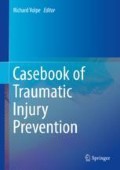Abstract
The Melbourne Extended Care and Rehabilitation Services for patient falls prevention program was initiated due to a high rate of falls in hospital settings and limited knowledge about risks or prevention measures. This comprehensive prevention program framework looked at the interactions between many different and wide-ranging potential factors to assess risk. The thorough risk assessment tool developed during the program has expanded its reach internationally and has also been adapted for use outside of the hospital to address falls in the community. Resulting prevention measures were equally exhaustive and addressed falls hospital prevention holistically. The Melbourne Extended Care and Rehabilitation Services prevention program is a model of the strengths a process evaluation framework brings to an injury prevention program. Because of this process evaluation framework and commitment to learning, the Melbourne Extended Care and Rehabilitation Services hospital prevention program contributed to falls prevention knowledge.
Access this chapter
Tax calculation will be finalised at checkout
Purchases are for personal use only
Notes
- 1.
While these same services still exist at the RMH, they are no longer housed under the name of MECRS and the organization is different. For more information about current rehabilitation and extended care services at the RMH, please visit their website: www.thermh.org.au
References
Chang, Y. W., Chang, Y. H., Pan, Y. L., Kao, T. W., & Kao, S. (2017). Validation and reliability of Falls Risk for Hospitalized Older People (FRHOP): Taiwan version. Medicine, 96(31), e7693.
Hill, K., Smith, R., & Schwarz, J. (2001). Falls clinics in Australia: A survey of current practice, and recommendations for future development. Australian Health Review, 24(4), 163–174.
National Ageing Research Institute. (2002). Preventing adverse events in sub-acute care: Changing practice to prevent falls. Report to the Metropolitan Health & Aged Care Services Divisions, Department of Human Services.
Russell, M. A., Hill, K. D., Day, L. M., Blackberry, I., Gurrin, L. C., & Dharmage, S. C. (2009). Development of the falls risk for older people in the community (FROP-Com) screening tool. Age and Ageing, 38(1), 40–46.
Acknowledgments
The author would like to express sincere appreciation to the key informants for this case study—Keith Hill and Freda Vrantsidis of the National Aging Research Institute in Parkville, Victoria, Australia—whose consultation made this project possible.
Author information
Authors and Affiliations
Editor information
Editors and Affiliations
Appendices
BRIO Model: MECRS Hospital Falls Prevention
Group Served: Patients in hospitals, mainly elderly patients.
Goal: Assess causes of falls in hospital settings and subsequently act to prevent them.
Background | Resources | Implementation | Outcome |
|---|---|---|---|
Risk of neurotrauma from falls is highest among those over 65 years of age Falls in subacute and rehabilitation settings can be associated with complications, psychological effects, and permanent institutionalization and can extend length of stay or necessitate diagnostic procedures Rates of falls in subacute settings is high with limited knowledge available about how to prevent them The program aimed to reduce falls within Melbourne Extended Care and Rehabilitation Service | Program was built on developmental activities already in existence at the institution. The DHS Aged Care Division at Melbourne funded this aspect The program the Department of Human Services Quality Improvement funded it | Retrospective evaluation of falls formed a baseline for the project Program included workforce, training workstations (SPLATT), research, patient and career focus groups, validation and implementation of a falls risk assessment tool, an environmental safety audit process review, audits of patients’ foot wear, review of patient nutrition, a bed/chair alarm, a fear of falling review, and an interaction with falls prevention activities | Feedback from the training initiative (SPLATT) was positive Advanced falls prevention training program was rated as very good or excellent by participants The action research component yielded several problems related to falls; strategies to address shoes, clothing, communication, and environmental hazards were developed Recommendations for fall prevention education were obtained via family/career focus groups Linkages between nutrition and falling were made |
Life Space Model: MECRS Hospital Falls Prevention
Sociocultural : civilization/community | Interpersonal: primary and secondary relationships | Physical environments: where we live | Internal states: biochemical/genetic and means of coping |
|---|---|---|---|
Raised awareness of fall risk factors and preventative practice among staff, patients, and families Program impacts the way in which falls were viewed by all involved in the Melbourne community | Interactive program design has the potential to create positive relations and networks among patients, families, and staff The way in which family and staff interact with patients will incorporate program knowledge | The identification of multifactorial antecedents to falls contribute to safety Empirical assessment of risk for falling protects safety Environmental audit process review makes the environment safer | Program can increase the quality of life, security, and self-efficacy among older patients |
Rights and permissions
Copyright information
© 2020 Springer Nature Switzerland AG
About this chapter
Cite this chapter
Gentili, D. (2020). Melbourne Extended Care and Rehabilitation Service Falls Prevention Project. In: Volpe, R. (eds) Casebook of Traumatic Injury Prevention. Springer, Cham. https://doi.org/10.1007/978-3-030-27419-1_16
Download citation
DOI: https://doi.org/10.1007/978-3-030-27419-1_16
Published:
Publisher Name: Springer, Cham
Print ISBN: 978-3-030-27418-4
Online ISBN: 978-3-030-27419-1
eBook Packages: MedicineMedicine (R0)

